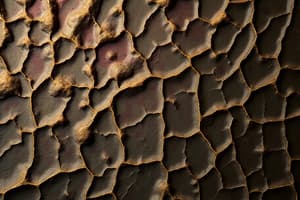Podcast
Questions and Answers
कौन-सा प्रकार का ऊतक हमें चलने में मदद करता है?
कौन-सा प्रकार का ऊतक हमें चलने में मदद करता है?
- संयोजनीय ऊतक
- मांसपेशिय ऊतक (correct)
- एपिथेलियल ऊतक
- तंत्रिका ऊतक
एपिथेलियल ऊतक की मुख्य कार्यक्षमता क्या है?
एपिथेलियल ऊतक की मुख्य कार्यक्षमता क्या है?
- भोजन को पचाना
- भारी वस्त्रों की निर्माण
- अंदरूनी अंगों को नियंत्रित करना
- स्पर्श और ताप का अनुभव करना (correct)
किस प्रकार का ऊतक हमें ह्रदय से रक्त पम्प करने में मदद करता है?
किस प्रकार का ऊतक हमें ह्रदय से रक्त पम्प करने में मदद करता है?
- संयोजनीय ऊतक (correct)
- एपिथेलियल ऊतक
- मांसपेशिय ऊतक
- तंत्रिका ऊतक
कौन सा ऊतक मौलिक ढांचे की सहायता प्रदान करने में सहायक होता है?
कौन सा ऊतक मौलिक ढांचे की सहायता प्रदान करने में सहायक होता है?
नस्तुलन, सरल, और ह्रदयी ऊतक किस प्रकार की मांसपेशिय पृष्ठी हैं?
नस्तुलन, सरल, और ह्रदयी ऊतक किस प्रकार की मांसपेशिय पृष्ठी हैं?
किस तंतु का काम है विभिन्न शरीरिक संरचनाओं के बीच जगह भरना और समर्थन और लचीलाता प्रदान करना?
किस तंतु का काम है विभिन्न शरीरिक संरचनाओं के बीच जगह भरना और समर्थन और लचीलाता प्रदान करना?
किस ऊतक में मांसपेशियों के गोलकों की परतें बनती हैं?
किस ऊतक में मांसपेशियों के गोलकों की परतें बनती हैं?
किस ऊतक में हमारे शरीर के संवेदनशीलता को संदेश भेजने और प्राप्त करने में मदद होती है?
किस ऊतक में हमारे शरीर के संवेदनशीलता को संदेश भेजने और प्राप्त करने में मदद होती है?
किस ऊतक में हमारे हड्डियों का कठीय पदार्थ समर्थन प्रदान करता है?
किस ऊतक में हमारे हड्डियों का कठीय पदार्थ समर्थन प्रदान करता है?
किस ऊतक में हमें मोटाई, पारदर्शिता, समर्थन, और पोषण-अपशिष्ट प्रसारित करने में मदद मिलती है?
किस ऊतक में हमें मोटाई, पारदर्शिता, समर्थन, और पोषण-अपशिष्ट प्रसारित करने में मदद मिलती है?
ह्रास्य, 3-1-3-1-3-1 संरेखित होने के कारण किस-2 ह्रास्य प्र'-स्त होता है?
ह्रास्य, 3-1-3-1-3-1 संरेखित होने के कारण किस-2 ह्रास्य प्र'-स्त होता है?
Flashcards are hidden until you start studying
Study Notes
Tissues: The Building Blocks of Life
Tissues are the fundamental structural and functional units of living organisms, where cells work together in specialized groups to carry out specific roles. A better understanding of tissues helps us appreciate the complexity of our bodies and the world around us. In this article, we'll focus on the three main types of tissues, their functions, and a closer look at connective tissue.
Types of Tissues
The human body is made up of four main types of tissues:
-
Epithelial tissue: This forms the outermost layer of our skin and lines internal organs like the kidney and stomach. Epithelial cells are tightly packed to create a barrier against the environment while allowing us to sense touch and temperature.
-
Muscle tissue: There are three types of muscle tissue: skeletal, smooth, and cardiac. Skeletal muscle allows us to move, smooth muscle helps control our internal organs, and cardiac muscle pumps blood throughout our bodies.
-
Nervous tissue: The brain and spinal cord are made of nervous tissue, which transmits electrical signals that initiate movement, control our senses, and regulate our emotions and behavior.
-
Connective tissue: Connective tissue, our focus for this article, is the most abundant and diverse type of tissue. It provides support, binds structures together, and transports nutrients and waste products throughout the body.
Functions of Tissues
Tissues work together to carry out essential functions like protecting us, allowing us to move, and regulating our body's processes.
- Protection: Epithelial tissue covers our skin and lines internal organs to protect us from infection and damage.
- Movement: Muscle tissue enables us to move our limbs, open and close our eyes, and pump blood through our bodies.
- Nerve impulses: Nervous tissue sends and receives signals to and from our brain and spinal cord, allowing us to think, feel, and move.
- Support and connection: Connective tissue provides structural support, connects body parts, and transports nutrients and waste through our bodies.
Connective Tissue
Connective tissue is the most diverse and abundant type of tissue in the body. It has several subtypes, and each plays a distinct role.
-
Areolar tissue: Also known as loose connective tissue, areolar tissue fills spaces between other body structures and provides support and flexibility.
-
Adipose tissue: This tissue stores energy in the form of fat. Adipose tissue also acts as an insulator, protecting our organs, and helping regulate body temperature.
-
Dense regular connective tissue: This tissue forms the layers of our skin and the sheaths surrounding muscles and tendons.
-
Dense irregular connective tissue: This tissue forms the ligaments that connect bones and cartilage, and the tendons that attach muscles to bones.
-
Elastic tissue: This flexible, stretchy tissue is found in our blood vessels and lungs. Elastic tissue allows organs like the lung to expand and contract, while blood vessels expand and contract to control blood pressure and blood flow.
-
Bone tissue: The hard, calcified tissue of bones provides structural support and protection for our bodies.
-
Cartilage tissue: Cartilage is a flexible yet strong connective tissue that provides structure and support to the body. Cartilage is found in our joints, nose, and trachea.
Connective tissue is a marvel of biological engineering, with the ability to adapt to our needs, repair itself, and prevent infection. Understanding connective tissue and its functions gives us a deeper appreciation for the complexity of our bodies and the world around us.
Studying That Suits You
Use AI to generate personalized quizzes and flashcards to suit your learning preferences.




